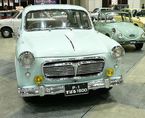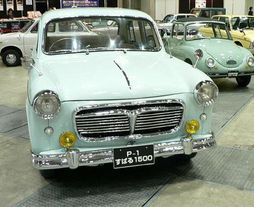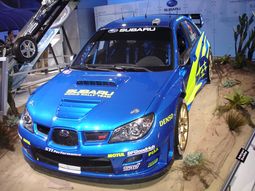The History Of Subaru

Subaru (スバル, Subaru?) is the automobile manufacturing division of Japanese transportation conglomerate Fuji Heavy Industries Co., Ltd. (FHI).
Subaru is known for their use of boxer engines in most of their vehicles. The company decided to utilize all wheel drive in most international markets as standard equipment in 1996. They also offer many turbocharged versions of their passenger cars, such as the Impreza WRX which is well-known in motorsports, such as rally racing. Other turbocharged models from Subaru include the Forester XT, Impreza STI and Legacy GT Spec.B.
Fuji Heavy Industries, the parent company of Subaru, is currently in a partnership with Toyota Motor Corporation, which owns 16.5% of FHI. The company is named after the star cluster Pleiades, which in Greek mythology is known as the Seven Sisters, and in Japanese the name is "Subaru", which roughly translated into English means, "to govern", "unite," or "gather together". The company logo is influenced by the star cluster. The large star in the logo represents Fuji Heavy Industries, and the five smaller stars represent the current five companies that are united under the FHI group.
FHI started out as The Aircraft Research Laboratory in 1917 headed by Chikuhei Nakajima. In 1932, the company was reorganized as Nakajima Aircraft Company, Ltd and soon became the primary manufacturer of aircraft for Japan during World War II. At the end of the Second World War Nakajima Aircraft was again reorganized, this time as Fuji Sangyo Co, Ltd. In 1946, the company created the Fuji Rabbit motor scooter with spare aircraft parts from the war. In 1950, Fuji Sangyo was divided into 12 smaller corporations according to the Japanese Government's 1950 Corporate Credit Rearrangement Act, anti-zaibatsu legislation, but between 1953-1955, four of these corporations and a newly formed corporation Fuji Kogyo, a scooter manufacturer; coachbuilders Fuji Jidosha; engine manufacturers Omiya Fuji Kogyo; chassis builders Utsunomiya Sharyo and the Tokyo Fuji Dangyo trading company decided to merge together to form the Fuji Heavy Industries known today.
Kenji Kita, the CEO of Fuji Heavy Industries at the time, wanted the new company to be involved in car manufacturing and soon began plans for building a car with the development code-name P-1. Mr. Kita canvassed the Company for suggestions about naming the P1, but none of the proposals were appealing enough. In the end, he gave the car a Japanese name that had been his personal favorite from childhood: Subaru. The first Subaru car was named the Subaru 1500. Only twenty P1s were manufactured due to multiple supply issues. From 1954 to 2008, the company designed and manufactured dozens of vehicles including the 1500 (1954), the tiny air-cooled 360 (1958), the Sambar (1961), the 1000 (1965), the R2 (1969), the Leone (1971), the Domingo (1983), the Alcyone (1985), the Legacy (1989), the Impreza (1993), the Sambar EV electric van (1995), the Forester (1997), the Tribeca (2005), and the Exiga (2008).
Major shareholders
On October 5, 2005 Toyota Motor Corporation purchased 8.7% of FHI shares from General Motors who had owned 20.1% of FHI since 1999. GM later divested its remaining 11.4% stake, selling its shares on the open market to sever all ties with FHI. FHI previously stated that there might have been 27 million shares (3.4%) acquired before the start of trading by an unknown party on October 6, 2005, and speculation suggested that a bank or perhaps another automaker was involved. After the purchase, Toyota announced a contract with Subaru on March 13, 2006 to use the underutilized Subaru manufacturing facility in Lafayette, Indiana, and Toyota announced plans to hire up to 1,000 workers and set aside an assembly line for the Camry model, beginning in spring 2007.
Before GM's ownership, Nissan had acquired a 20% stake in 1968 during a period of government-ordered merging of the Japanese auto industry in order to improve competitiveness under the administration of Prime Minister Eisaku Sato. Nissan would utilize FHI's bus manufacturing capability and expertise for their Nissan Diesel line of buses. In turn, many Subaru vehicles, even today, use parts from the Nissan manufacturing keiretsu. The Subaru automatic transmission, known as the 4EAT, is also used in the first generation Nissan Pathfinder. Speculation has suggested that it was Subaru that introduced Renault to Nissan, when Nissan asked for assistance in all-wheel drive (AWD) technology, and when FHI might have suggested that Renault discuss their plans with Nissan, the discussions may have been a contributing factor to the currently successful Renault-Nissan alliance. Upon Nissan's acquisition by Renault, its 20% stake was sold to General Motors.
During the brief General Motors period, a "badge engineered" Impreza was sold in the United States as the Saab 9-2X. A SUV (Subaru Tribeca / SAAB 9-6X) was also planned but the SAAB version did not proceed.
Marketing efforts
In 1965, Malcolm Bricklin started selling franchises for motor scooters that included the Fuji Rabbit and the tiny Subaru 360. Bricklin made a deal with Subaru to introduce those cars to the United States. Malcolm and his partner, Harvey Lamm, formed Subaru of America, Inc. to sell Subaru franchises. It marked the beginning of the Japanese influx.
In the 1970s, the company moved away from small commercial vehicles and concentrated on the development of mainstream passenger car models with the Subaru Leone, and when Subaru continued in their endeavours, and introduced the Legacy in 1989, it was a sales success for the company. The Legacy was considered mainstream in its appearance and a departure from previous vehicles, which had earned a reputation of being "quirky". It was perceived by some as Subaru's attempt to compete with new luxury brands Lexus, Infiniti and Acura, as Japanese vehicles were increasing in popularity, particularly in the USA. Subaru continued their new direction with the controversially styled six-cylinder SVX (1992), and the Impreza (1993).
From 1995 to 2000, Subaru ran a series of advertisements for the newly developed Subaru Outback which starred Paul Hogan. The advertisements were intended to highlight Subaru's all wheel drive, and depicted the Outback in a number of rugged Australian locations. The tagline "the world's first sport utility wagon" was successfully used by Subaru, though the AMC Eagle had tried much the same idea, with less success in the 1980s. Some of the advertising slogans Subaru has used in the past include, "Inexpensive, and built to stay that way", "The World's Favorite Four Wheel Drive" (in the U.K.), "We're building our reputation by building a better car", "The beauty of all-wheel-drive", "Think, Feel, Drive", and currently "It's what makes a Subaru, a Subaru".
As a result of this refocused advertising campaign, Subaru products began to attract a following among the young and educated, and as a lightweight, affordable, economical SUV alternative to the likes of the Ford Bronco and Jeep Wagoneer or the exclusive Volvo. Subaru was among the first automotive companies to market to gays and lesbians in the US. Subaru has historically been popular in US regions such as the Pacific Northwest , the North American Rocky Mountains region, and especially in New England, with relatively high resale values and owner loyalty rates in those regions. According to Automotive Lease Guide, Subaru ranked second place in vehicles that have the highest overall predicted resale values among all industry and all luxury vehicles for MY 2009. The awards are derived after carefully studying segment competition, historical vehicle performance and industry trends. According to a study done by J.D. Power and Associates, for the 2008 Customer Retention Study, Subaru ranked at 50.5%, which was above the national average of 48%.
Motorsports
Modified versions of the Impreza WRX and WRX STi have been competing successfully in rallying; drivers Colin McRae (1995), Richard Burns (2001) and Petter Solberg (2003) have won World Rally Championship drivers' titles with the Subaru World Rally Team, and Subaru took the manufacturers' title three years in a row from 1995 to 1997. Subaru's World Rally Championship cars are prepared and run by Prodrive, the highly successful British motorsport team. Several endurance records were set in the early and mid-nineties by the Subaru Legacy.
For the 1990 Formula One season, Subaru fielded the Subaru Coloni C3B. It featured a 12 cylinder boxer engine, but was not competitive because of horsepower and weight disadvantages. With the rise of rally racing, and the Import scene in the US, the introduction of the highly anticipated Subaru Impreza WRX in 2001 was successful in bringing high performance, AWD compact cars into the sports car mainstream.
On the 16 December 2008, it was announced that Subaru would no longer be competing in the World Rally Championships, due to the issues with the current global economic crisis, combined with the prospect of a car which still needed development for the 2009 season and a change in regulations for the 2010 season.
Diesel
Subaru displayed a variable vane, common rail turbodiesel boxer engine at the 2007 Frankfurt International Motor Show. It is the world's first production horizontally-opposed water-cooled diesel engine. Volkswagen made only 2 air-cooled boxer prototype diesel engines that were not turbocharged, and installed one engine in a Type 1 and another in a Type 2.
The Subaru engine was rated at 110kW (150PS; 148hp) and 350N·m (260ft·lbf) with a displacement of 2.0 litres. In March 2008, Subaru offered the Legacy wagon and the Outback wagon with the 2.0 litre turbodiesel in the EU with a 5 speed manual transmission only.
In September 2008, Subaru announced that the diesel Forester and diesel Impreza will be introduced at the 2008 Paris Motor Show, with Forester sales to begin October 2008 and diesel Impreza sales to start January 2009. The Forester and Impreza will have a 6 speed manual transmission only, whereas the Legacy and Outback have 5 speed manual transmissions only.
United States Environmental Protection Agency fuel economy estimated is: City Ranges 32.7mpg-US (7.19L/ 100km; 39.3mpg-imp) 33.6mpg-US (7.00L/ 100km; 40.4mpg-imp)
Highway Ranges 45.2mpg-US (5.20L/ 100km; 54.3mpg-imp) 49.0mpg-US (4.80L/ 100km; 58.8mpg-imp)
The fuel economy ratings listed are comparable to the Smart ForTwo.
According to the Subaru Owners on-line newsletter dated March 2008, Subaru is "currently making modifications to the diesel so it meets the more stringent US standards. Subaru diesel models should be domestically available in two to three years."
Subaru claims to have implemented advanced policies which include recycling, reducing harmful emissions, educating their employees, and continuing their efforts have helped them in their environmental initiatives. The Subaru plant in Lafayette, Indiana (SIA) was the first auto assembly plant to achieve zero landfill status - nothing from its manufacturing efforts goes into a landfill. The company has also developed energy efficient hybrid vehicles as well as a recycling plan for their "end-of-life" cars. Most of their modern products use aluminium throughout the vehicle, in the engine, transmission, suspension and elsewhere in each vehicle, that can be recycled when the vehicle is no longer servicable.
An excerpt from the Subaru website stated "In 2006, SIA was awarded the U.S. EPA's Gold Achievement Award as a top achiever in the agency's WasteWise program to reduce waste and improve recycling." The website also stated that "It also became the first U.S. automotive assembly plant to be designated a wildlife habitat."
Subaru also offers Partial Zero Emissions Vehicle (PZEV) certified Legacy, Outback, and Forester models which are available for sale anywhere in the U.S. Other car makers limit vehicles certified as PZEV in states that have adopted California emission standards. Subaru PZEV vehicles meet California's Super-Ultra-Low-Emission Vehicle exhaust emission standard. All other models have been certified LEV2.
North America/ Europe/ Oceania/ Middle East/ Asia/ Japan Subaru models, permanent all wheel drive with boxer engine.
- Exiga
- Forester
- Impreza
- WRX & WRX STI
- Outback Sport / Gravel Express / Impreza RV
- Justy
- Legacy / Liberty
- Outback / Grand Wagon / Lancaster
- Tribeca
The following models are sold in Asia and Europe. In Japan, they are in the Kei car class, with either front or all wheel drive, and a straight engine:
- Pleo
- R1
- R2
- Sambar
- Stella
An article posted by Autoblog on April 16, 2008 stated that due to the corporate investment by Toyota, all kei cars built by Subaru will be replaced by Daihatsu models beginning in 2010
- 360
- 1500
- 1000
- Alcyone XT
- Alcyone SVX
- Baja
- BRAT
- FF-1 G
- FF-1 Star
- Justy
- Leone
- Sumo
- REX
- Traviq
- Vivio
- Libero
- Subaru SRD-1 Experimental design study introduced in 1990
- 1996 Subaru Exiga
- Subaru B9 Scrambler
- Subaru B11s
- Subaru B5 TPH (Turbo Parallel Hybrid)
December 4, 2007 saw an article claiming that Subaru was considering building a motorcycle, called the Subaru HS500, with a single cylinder 500 cc engine producing 50hp (37kW). Subaru HS500
Toyota-Subaru coupe
On April 10, 2008, Toyota approximately doubled its stake in FHI to 16.5%, and announced that Toyota and Subaru are working on a 2-door coupe together, to be released around 2011. The purchase was made legal on June 27, 2008.
According to an article posted by Autoblog on May 28, 2008, the coupe that Toyota and Subaru are working on together will be sold in Japan only as a Toyota, and internationally as a Subaru. The Subaru version is initially being branded as an Impreza coupe, with the powertrain being described as RWD with the 2.0 liter boxer engine, and optional 2.5 turbo from the WRX STi and AWD. Spy photos of a prototype testing mule were taken in the UK, heavily disguised using Legacy bodywork on a shortened frame.. It has been suggested that the Toyota version could be a revival of the Toyota Levin/ Trueno. According to an article posted by Carscoop.com, the Toyota coupe will be sold as the next generation Scion tC, to be introduced in 2011. An article posted December 22 on Autoblog stated that the Toyota-Subaru coupe has been delayed until 2012.
From Wikipedia, the free encyclopedia
More About Subaru



|